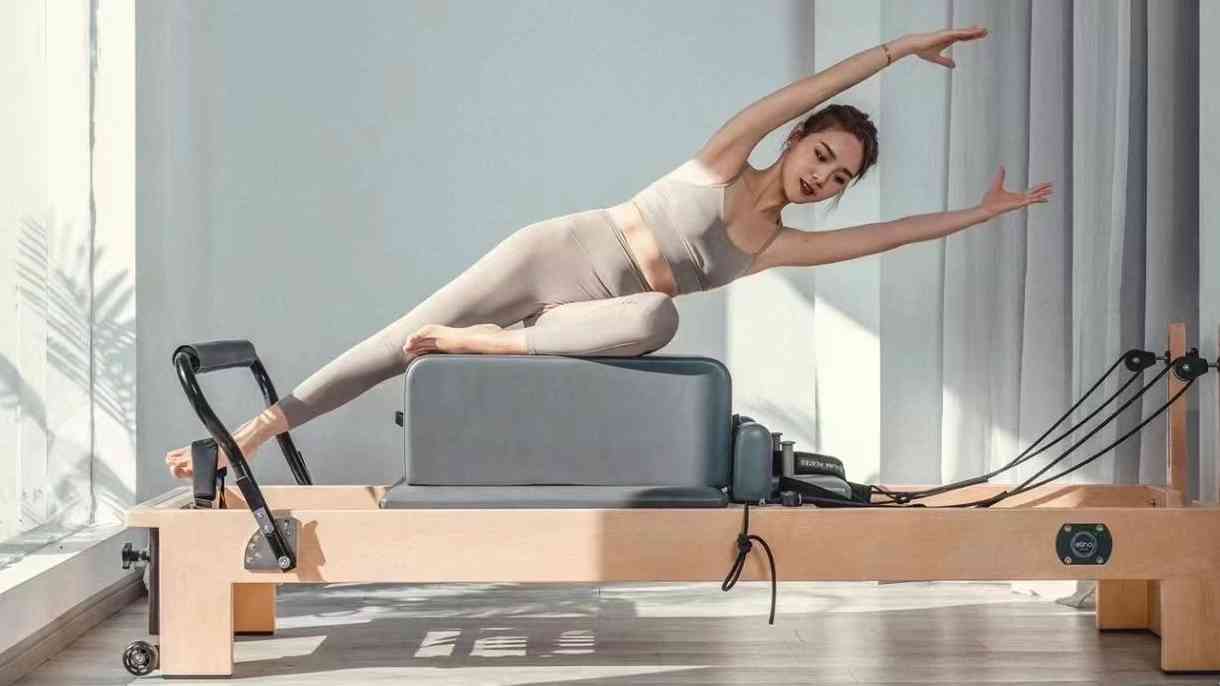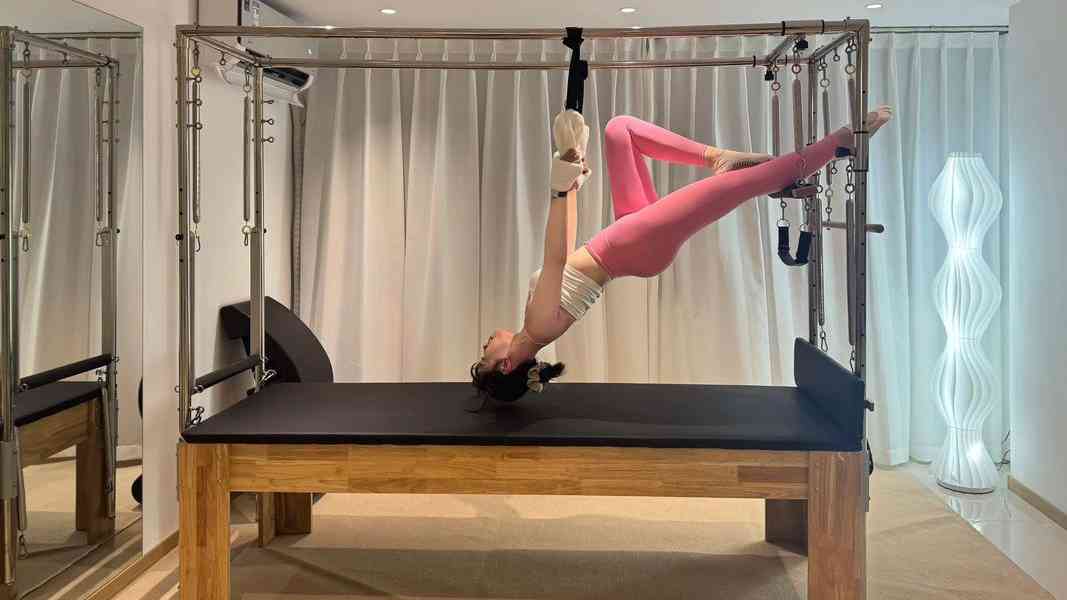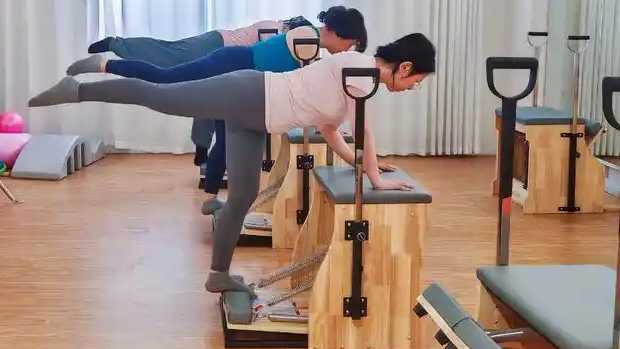Once you've mastered the basics, advanced Pilates exercises on the Reformer, Cadillac, or Chair can take your strength, flexibility, and control to the next level. These moves challenge your core, improve stability, and deepen your mind-body connection.
✅ Reformer: The Advanced Landscape
Once you've mastered the fundamentals of Reformer Pilates, advanced exercises can challenge your strength, stability, and body awareness even further. These movements are designed to engage multiple muscle groups simultaneously, refine control, and deepen flexibility. Two notable advanced exercises are The Snake and The Overhead.
1. The Snake
Focus: Core integration, spinal mobility, and balance
The Snake is an intricate Reformer exercise that combines rotational movements with precise control of the carriage. Starting in a seated or kneeling position, you engage the core while moving the carriage laterally or in a circular pattern. The exercise challenges oblique activation, spinal articulation, and dynamic stabilization through the torso, shoulders, and hips.
Key Points:
* Maintain a neutral spine and controlled breathing throughout.
* Avoid collapsing the shoulders or allowing the pelvis to tilt excessively.
* Focus on smooth, flowing motions rather than speed to fully engage stabilizing muscles.
2. The Overhead
Focus: Upper body strength, shoulder stability, and core control
The Overhead involves extending the arms overhead while maintaining alignment on the carriage, often combined with leg movements or carriage travel. This exercise strengthens the shoulders, upper back, and core, while also improving posture and shoulder mobility.
Key Points:
* Keep your core engaged and ribs stabilized to protect the lower back.
* Move the carriage slowly, ensuring even tension through the springs.
* Avoid locking the elbows completely; maintain micro-bends for joint safety.

Why These Exercises Matter?
Advanced Reformer exercises like The Snake and The Overhead push the boundaries of traditional Pilates movements. They require coordination, precision, and strength, helping practitioners refine mind-body connection, improve functional fitness, and achieve greater muscular balance. Incorporating these into your practice ensures continuous growth and mastery of the Reformer.
✅ Cadillac: The Elite Frontier
The Cadillac, also known as the Trapeze Table, is one of the most versatile and advanced pieces of Pilates equipment. Its combination of springs, bars, and trapeze attachments allows for complex exercises that challenge strength, stability, and flexibility in ways few other machines can. For advanced practitioners, exercises like Hanging Pull-Ups and Bicycle in the Air push the boundaries of core control and full-body coordination.
1. Hanging Pull-Ups
Focus: Upper body strength, scapular stability, and core engagement
Hanging Pull-Ups on the Cadillac utilize the trapeze bar or push-through bar to lift and lower the body in a controlled manner. This exercise recruits the arms, shoulders, and back while demanding strong core stabilization to maintain alignment throughout the movement. It's a high-level exercise that also improves grip strength and coordination.
Key Points:
* Keep the shoulders down and away from the ears to protect the neck.
* Engage the abdominal muscles to stabilize the spine.
* Move slowly and with control, focusing on smooth carriage and bar motion.
2. Bicycle in the Air
Focus: Core strength, hip mobility, and coordination
The Bicycle in the Air challenges the abdominal muscles and hip flexors while coordinating alternating leg movements. Suspended straps or the Cadillac's vertical springs provide resistance and support, allowing the practitioner to pedal the legs in a bicycle-like motion while maintaining a lifted, engaged torso.
Key Points:
* Keep the core drawn in and the lower back long to avoid arching.
* Move the legs in a controlled, rhythmic pattern rather than rushing through repetitions.
* Focus on maintaining even resistance and smooth motion for optimal engagement.

Why These Exercises Matter?
These advanced Cadillac exercises exemplify the machine's elite capabilities. They require a combination of strength, flexibility, and precise control, making them ideal for experienced practitioners aiming to push their Pilates practice to the next level. Regularly incorporating these movements can improve muscular balance, coordination, and full-body integration.
We are committed to delivering exceptional support and
top-tier service whenever you need it!
✅ Chair: The Pinnacle of Precision
The Pilates Chair, also known as the Wunda Chair, is a compact yet highly challenging piece of equipment. Its small footprint belies its ability to test strength, balance, and control. Advanced exercises on the Chair demand precision and full-body engagement, making it ideal for practitioners looking to refine stability and coordination. Two standout exercises are The Tendon Stretch and The Handstand.
1. The Tendon Stretch
Focus: Calf and hamstring flexibility, core stability, and ankle mobility
The Tendon Stretch involves standing on the Chair with the heels lifted or extended over the pedal, pressing down to engage the legs while maintaining a neutral spine. This exercise stretches the calves and hamstrings while simultaneously activating the core to control the movement.
Key Points:
* Keep the pelvis neutral and the spine long.
* Engage the abdominals to prevent overarching the lower back.
* Move slowly and with control to fully engage leg and core muscles.
2. The Overhead
Focus: Upper body strength, shoulder stability, and balance
The Handstand on the Chair is a highly advanced move that requires lifting the body upside down with hands on the pedal. This exercise develops the shoulders, arms, and core, while enhancing proprioception and balance. It is often used by experienced practitioners to build confidence in inverted positions.
Key Points:
* Engage the core fully to maintain alignment and avoid sagging in the back.
* Keep shoulders strong and away from the ears to protect the neck.
* Start with small lifts or partial handstands before progressing to full extensions.

Why These Exercises Matter?
The Tendon Stretch and Handstand exemplify the precision and control the Chair offers. Both exercises engage multiple muscle groups simultaneously and require mindful movement. Mastering these exercises enhances strength, stability, flexibility, and balance, highlighting the Chair's unique role in advanced Pilates training.
✅ Conclusion
Advanced Pilates exercises offer endless opportunities to grow your practice safely and effectively. With proper guidance and consistent training, you can enhance your strength, mobility, and overall spinal health.

Talk To Our Experts
Connect with an NQ expert to discuss your product needs
and get started on your project.
✅ FAQs About Pilates Reformer
1. Who should attempt advanced Pilates exercises on these machines?
Advanced Pilates exercises are best suited for individuals with strong foundational Pilates experience, good core stability, and body awareness. Beginners should focus on mastering basic movements before progressing to avoid injury.
2. How do Reformer, Cadillac, and Chair exercises differ in challenge?
Reformer: Offers dynamic resistance and fluid carriage movement, emphasizing controlled full-body integration.
Cadillac: Provides multiple attachments for vertical and suspension exercises, making it ideal for strength, flexibility, and stability challenges.
Chair: Compact and unstable, requiring high levels of balance, core control, and precision for advanced movements.
3. Are these advanced exercises safe to do at home?
Whether or not you need professional help to assemble your Pilates reformer depends on several factors, including the model you’ve purchased, your comfort level with assembly, and the complexity of the reformer itself. Let’s break down the pros and cons of assembling it yourself versus hiring a professional.
4. What are some examples of advanced exercises for each machine?
Reformer: The Snake, The Overhead, Long Stretch Variations
Cadillac: Hanging Pull-Ups, Bicycle in the Air, Roll-Over with Straps
Chair: The Tendon Stretch, Handstand, Pike Press
5. How can you safely progress to these exercises?
Master foundational exercises first
Gradually increase spring resistance or range of motion
Focus on precise form and controlled breathing
Consider professional guidance or small incremental challenges before attempting full advanced moves
6. What are the main benefits of practicing advanced exercises?
Advanced exercises develop core strength, muscular coordination, flexibility, balance, and body awareness. They also refine mind-body connection and prepare you for functional movement in everyday life or other athletic activities.
7. How often should advanced Pilates exercises be incorporated into a routine?
Depending on your fitness level, 1–3 sessions per week focusing on advanced moves is recommended. Always include proper warm-ups, foundational exercises, and allow rest or active recovery days to prevent overuse or fatigue.
Post time: Aug-18-2025
